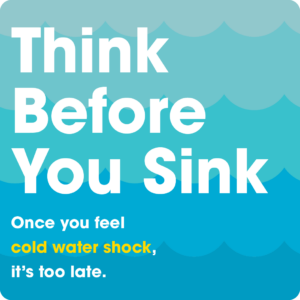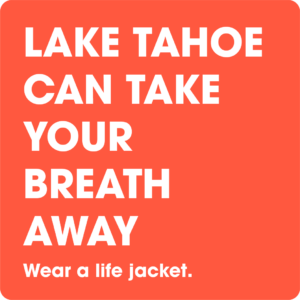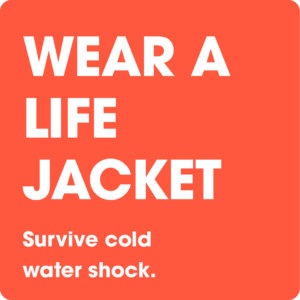Cold Water Shock Kills. Wear a Lifejacket.
Cold water shock is a real risk: an average of seven people drown in Lake Tahoe every year due to cold water shock.
Cold water shock occurs when the body enters extremely cold water and the muscles lock up, resulting in temporary paralysis. Cold water shock doesn’t care how fit you are, or how strong of a swimmer you are, Tahoe’s cold waters will paralyze you and you will drown. Period.
Tahoe’s water is generally warmer in summer, but upwelling events, where cold water from deep in the lake rises to the surface, can happen at any time and are more common out in the middle of the lake. Because of the large temperature difference from sitting in the sun to jumping into an Alpine lake, cold water shock can happen at any temperature.
Lake Tahoe is wider than it looks, and deeper than you can imagine. Drownings are not always due to solo excursions; there are usually other people around, but the body shuts down so quickly that they cannot be rescued. Wearing a life vest at all times is the best way to protect yourself from cold water shock.
By law, all boaters on Lake Tahoe must have a life vest with them at all times while on the lake. Children under 13 years old must be wearing their life vest at all times. These laws save lives. Adults are recommended to wear their life vests at all times as well.
Facts about Cold Water Shock:
- The first stage of cold water shock can last up to three minutes.
- Cold water shock is most prevalent in water temperatures below 59 degrees Fahrenheit. However, it can occur in any temperature.
- Within 15 minutes in cold water, blood flow decreases to the extremities in an effort to preserve heat at the core. You will lose movement of legs and arms and will be unable to stay afloat unless you are wearing a life vest.
- Breathing rates can increase by 10 times during cold water shock.
- 55 percent of all open water drownings occur within 10 feet of safe refuge.
- 66 percent of people who drown in cold water are regarded as strong swimmers.
Stay Up To Date on Lake Conditions
Thinking about swimming in the lake or going for a paddle? Check out the UC Davis Tahoe Environmental Research Center Lake Conditions site. Find live conditions and forecasted models for water temperature, wave height, and water currents.
Lake Tahoe’s water temperatures can change fast. Upwelling events bring cold water to the surface at unexpected times. Know before you go… swimming!
Follow Proper Boating Etiquette on Lake Tahoe
Watch the Tahoe Boating Safety video below. Then, be sure to download the Tahoe Boating App to get up-to-date, location-specific information about no-wake zone boundaries, area attractions, and how to enjoy the lake safely and responsibly.
Paddle with a plan
Are you ready for an Endless Paddle Summer? The Lake Tahoe Water Trail is your one-stop planning resource for paddling on Lake Tahoe. Find maps, access information, rentals and tours, safety information, weather, and more. Lake Tahoe is breathtaking, but don’t let it take your breath away.


 Interested in printing out your own posters to spread awareness about cold water shock? Find poster designs here. If you are interested in ordering more stickers to put on rental boats or other watercraft, please email [email protected].
Interested in printing out your own posters to spread awareness about cold water shock? Find poster designs here. If you are interested in ordering more stickers to put on rental boats or other watercraft, please email [email protected].
Additional Resources and information:
- National Center for Cold Water Safety
- South Tahoe Now Cold Water Shock Article
- Lake Tahoe Water Trail Boating Regulations
- U.S. Coast Guard Auxiliary Boating Safety Education
- North Lake Tahoe Boating Safety





























